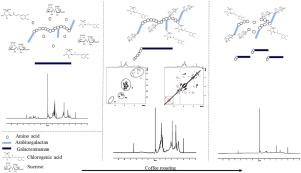当前位置:
X-MOL 学术
›
J. Food Compos. Anal.
›
论文详情
Our official English website, www.x-mol.net, welcomes your
feedback! (Note: you will need to create a separate account there.)
Use of NMR techniques to investigate the changes on the chemical composition of coffee melanoidins
Journal of Food Composition and Analysis ( IF 4.0 ) Pub Date : 2020-04-01 , DOI: 10.1016/j.jfca.2019.103399 Beatriz Ripper , Carlos R. Kaiser , Daniel Perrone
Journal of Food Composition and Analysis ( IF 4.0 ) Pub Date : 2020-04-01 , DOI: 10.1016/j.jfca.2019.103399 Beatriz Ripper , Carlos R. Kaiser , Daniel Perrone

|
Abstract We aimed to investigate the effect of roasting time on the chemical structure of coffee melanoidins and how the incorporation of chlorogenic acids (CGA) occurs using one-dimensional and two-dimensional Nuclear Magnetic Resonance spectroscopy (1D and 2D NMR). 1H NMR spectra showed large signals suggestive of proteins and polysaccharides due to their reduced intrinsic mobility. The spectra also revealed that melanoidins molecular weight increased during intermediate times of roasting and slightly decrease thereafter. In roasted samples, HSQC 2D NMR spectra showed 1H,13C cross-peaks from aromatic and olefinic groups of CGA. COSY 2D NMR experiments without and with enrichment of 5-caffeoylquinic acid standard allowed the detection of all 1H,1H cross-peaks from CGA, suggesting their intact incorporation, which was confirmed by a 1H NMR experiment using a T2-filter to remove large signals from macromolecules. Together, our results show that CGA are linked to coffee melanoidins by strong chemical bonds.
中文翻译:

使用核磁共振技术研究咖啡黑素化学成分的变化
摘要 我们旨在使用一维和二维核磁共振光谱(1D 和 2D NMR)研究烘焙时间对咖啡类黑素化学结构的影响以及绿原酸 (CGA) 的掺入是如何发生的。1H NMR 光谱显示大信号暗示蛋白质和多糖,因为它们的固有迁移率降低。光谱还显示,类黑素的分子量在烘烤的中间时间增加,然后略有下降。在烘焙样品中,HSQC 2D NMR 光谱显示来自 CGA 的芳族和烯属基团的 1H、13C 交叉峰。没有和富集 5-咖啡酰奎宁酸标准品的 COZY 2D NMR 实验允许检测来自 CGA 的所有 1H,1H 交叉峰,表明它们完整掺入,使用 T2 过滤器从大分子中去除大信号的 1H NMR 实验证实了这一点。总之,我们的结果表明 CGA 通过强化学键与咖啡类黑素相连。
更新日期:2020-04-01
中文翻译:

使用核磁共振技术研究咖啡黑素化学成分的变化
摘要 我们旨在使用一维和二维核磁共振光谱(1D 和 2D NMR)研究烘焙时间对咖啡类黑素化学结构的影响以及绿原酸 (CGA) 的掺入是如何发生的。1H NMR 光谱显示大信号暗示蛋白质和多糖,因为它们的固有迁移率降低。光谱还显示,类黑素的分子量在烘烤的中间时间增加,然后略有下降。在烘焙样品中,HSQC 2D NMR 光谱显示来自 CGA 的芳族和烯属基团的 1H、13C 交叉峰。没有和富集 5-咖啡酰奎宁酸标准品的 COZY 2D NMR 实验允许检测来自 CGA 的所有 1H,1H 交叉峰,表明它们完整掺入,使用 T2 过滤器从大分子中去除大信号的 1H NMR 实验证实了这一点。总之,我们的结果表明 CGA 通过强化学键与咖啡类黑素相连。











































 京公网安备 11010802027423号
京公网安备 11010802027423号